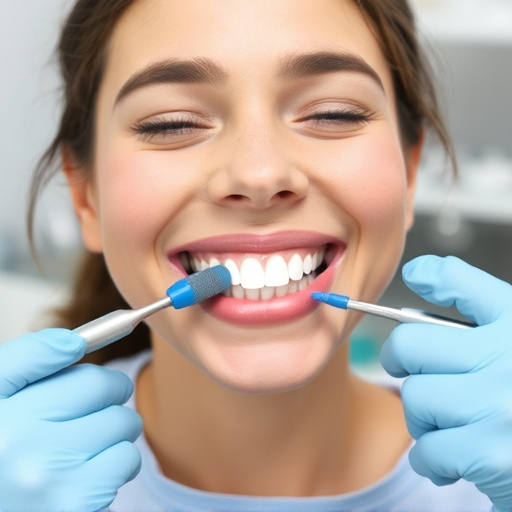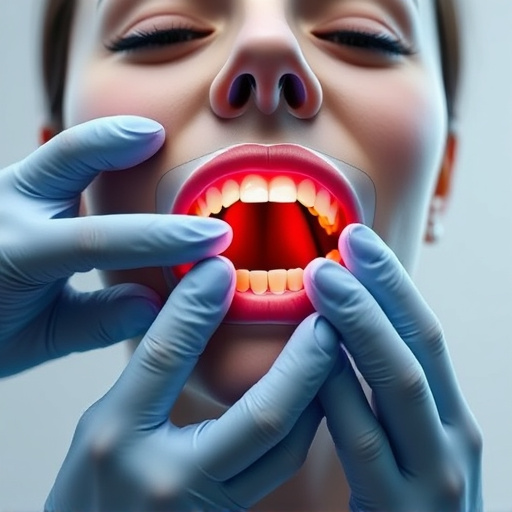Bad Breath Treatment: Targeting Bacteria for Long-Lasting Freshness
Bad breath (halitosis) is caused by bacterial growth in the mouth producing volatile sulfur compound…….
Bad breath, or halitosis, is a common dental and oral health issue that affects individuals globally. It refers to an unpleasant odor originating from the mouth and can have various causes, ranging from poor oral hygiene to systemic health conditions. Effective bad breath treatment involves a multi-faceted approach, addressing both symptomatic relief and underlying causes. This article aims to provide an in-depth exploration of bad breath treatment, its historical evolution, global impact, economic implications, technological innovations, regulatory landscape, challenges, successful case studies, and future prospects. By delving into these aspects, readers will gain a comprehensive understanding of this critical health concern and the strategies employed to combat it.
Definition: Bad breath treatment encompasses the practices, therapies, and products designed to eliminate or reduce oral malodors. It involves assessing and addressing various factors contributing to halitosis, ensuring a fresh and healthy mouth.
Core Components:
Oral Hygiene: Proper brushing techniques, tongue cleaning, and regular dental visits are fundamental. Removing plaque buildup on teeth and the tongue is crucial as it prevents bacteria from producing volatile sulfur compounds (VSCs), the primary cause of bad breath.
Professional Cleaning: Dentists perform deep cleaning procedures like scaling and root planing to eliminate tartar and cure gum diseases, which can be significant contributors to halitosis.
Antibacterial Agents: Mouthwashes containing antibacterial compounds or zinc ions help reduce bacterial populations in the mouth, thereby minimizing VSC production.
Dental Restorations: Treating oral conditions like tooth cavities, infections, or damaged fillings addresses specific causes of bad breath.
Dietary Modifications: Certain foods and drinks can impact breath odor. Avoiding garlic, onions, and strong-flavored foods, along with staying hydrated, can significantly improve breath freshness.
Historical Context:
The quest for treating bad breath dates back centuries. Ancient civilizations like the Greeks and Romans used various natural remedies, such as salt water rinses and herbal concoctions, to combat oral malodor. In modern times, the field of periodontology (dental disease prevention) has made significant strides in understanding halitosis, leading to more effective treatment strategies.
Bad breath is a universal concern, but its prevalence and management vary across regions:
North America and Europe: These regions have advanced dental healthcare systems, with higher awareness of oral hygiene practices and access to specialized bad breath treatment products. However, factors like smoking and specific dietary habits can contribute to regional variations in halitosis rates.
Asia Pacific: Rapidly growing economies in this region are witnessing increased adoption of modern dental care, leading to improved bad breath treatment accessibility. Cultural preferences for certain foods can also influence the types of oral malodors encountered.
Latin America and Middle East: These areas often face challenges related to limited access to dental services and educational resources regarding proper oral hygiene, impacting overall bad breath management.
Global trends indicate a growing demand for over-the-counter (OTC) bad breath treatment products, with an estimated market size of USD 3.5 billion in 2021, projected to reach USD 4.8 billion by 2026. This growth is attributed to rising dental health awareness and changing consumer preferences.
The bad breath treatment market operates within a complex economic framework:
Market Size and Growth: As mentioned, the global market witnessed substantial growth in recent years, driven by factors like increasing dental health expenditures and the rise of e-commerce platforms for oral care products.
Investment Patterns: Private equity firms and venture capitalists have shown interest in innovative bad breath treatment startups, fueling research and development (R&D) efforts. This investment climate encourages the creation of advanced technologies and products.
Cost-Effectiveness: Effective bad breath treatment not only improves oral health but also has positive economic implications. Reduced dental treatments due to better preventive care can lower healthcare costs for individuals and insurance providers.
Technology plays a pivotal role in enhancing bad breath treatment strategies:
Smart Oral Care Devices: Electric toothbrushes with built-in sensors provide real-time feedback on brushing techniques, while smart water flossers offer precise oral care. These devices enable individuals to take a more proactive approach to oral hygiene.
Oral Health Wearables: Wearable sensors can monitor breath composition and detect early signs of dental issues. These technologies allow for continuous data collection, aiding in personalized treatment plans.
Lasers and Advanced Cleaning Techniques: Dental lasers have revolutionized deep cleaning procedures, offering greater precision and faster healing times compared to traditional methods.
Digital Imaging and 3D Modeling: Computed tomography (CT) scans and 3D printing enable dentists to create customized oral appliances for improved treatment outcomes.
The regulatory landscape surrounding bad breath treatment varies across jurisdictions but aims to ensure product safety and efficacy:
Food and Drug Administration (FDA): In the United States, the FDA regulates OTC dental products, including mouthwashes and breath freshening strips. Manufacturers must provide evidence of product safety and effectiveness.
European Union (EU) Regulations: The EU has established stringent rules for oral care products, particularly concerning claims made on packaging. The EU’s Cosmetics Regulation ensures product safety and transparency.
International Standards: Organizations like the International Organization for Standardization (ISO) develop guidelines for dental devices, ensuring global consistency in quality and performance.
Despite significant progress, bad breath treatment faces several challenges:
Stigma and Misinformation: Social stigma associated with bad breath can lead to anxiety and avoidance of social situations. Misconceptions about the causes and treatments contribute to inadequate oral care practices.
Access to Care: Limited access to dental services in underserved communities hinders proper bad breath management, especially in low-income regions.
Product Effectiveness: With a vast array of products available, consumers may struggle to choose the most effective ones. Marketing claims can be misleading, creating confusion.
Strategies for Improvement:
Awareness Campaigns: Educating the public about bad breath causes, symptoms, and prevention techniques is crucial. Public health initiatives can dispel myths and promote oral hygiene.
Community Dental Programs: Expanding access to dental care through community clinics and mobile units addresses the issue of limited resources in underserved areas.
Regulatory Clarity: Clearer product labeling and standardized claims can help consumers make informed choices, ensuring product transparency.
Case Study 1: Community-Based Bad Breath Program in India
A non-profit organization initiated a program to combat bad breath among urban poor communities in India. The initiative focused on:
Outcome: After one year, the program achieved a 35% reduction in bad breath prevalence among participants. This success highlights the potential of community-driven interventions in improving oral health outcomes.
Case Study 2: Smart Mouthwear Technology in Japan
A Japanese startup developed wearable mouthpieces that monitor breath composition in real time. These devices provide personalized feedback on dietary habits and oral hygiene practices.
Market Impact: The product gained popularity among young adults, leading to improved oral care routines. This case demonstrates the appeal of tech-driven solutions for bad breath management.
The bad breath treatment landscape is poised for significant growth and innovation:
Personalized Medicine: Advancements in genetics and technology will enable personalized bad breath treatment plans, considering individual genetic predispositions and lifestyle factors.
Teledentistry: Remote dental consultations via video conferencing can improve access to care, especially in rural areas. This trend is expected to gain momentum with evolving technology.
Natural and Alternative Treatments: There will be a growing emphasis on natural remedies and alternative therapies, such as essential oils and herbal extracts, for bad breath control.
Global Collaboration: International partnerships can lead to the sharing of best practices, technological innovations, and resource allocation, ultimately enhancing global oral health outcomes.
Bad breath treatment is a dynamic field that continues to evolve, addressing the complex needs of individuals worldwide. From historical roots to cutting-edge technology, this comprehensive overview highlights the significance of bad breath management in overall dental and systemic health. As the global market expands and new trends emerge, continued research, education, and access to care will be crucial in ensuring fresh, healthy mouths for all.
Q: How can I determine if I have bad breath?
A: Bad breath (halitosis) is often noticeable to others but can be challenging to self-diagnose. Persistent oral malodors, especially after brushing and flossing, are indicators. Keep an eye on any changes in breath smell and consult a dentist for a professional assessment.
Q: What causes bad breath?
A: Bad breath primarily results from bacterial buildup in the mouth, particularly on the tongue and between teeth. Poor oral hygiene, dry mouth, certain foods, and health conditions like gum disease or sinus infections can contribute to halitosis.
Q: Are there any home remedies for bad breath?
A: While some natural remedies like baking soda rinses or parsley can provide temporary relief, consistent oral care practices are essential. Proper brushing, tongue cleaning, hydration, and maintaining a balanced diet are fundamental for long-term bad breath control.
Q: How often should I get my teeth professionally cleaned?
A: The frequency depends on your dental health status. For most people, professional cleanings every 6 months are recommended to remove plaque and tartar buildup. However, your dentist may suggest more frequent visits based on your oral care needs.
Q: Can stress cause bad breath?
A: Stress can indirectly contribute to bad breath. It often leads to poor eating habits, increased smoking or alcohol consumption, and decreased self-care, all of which are known halitosis triggers. Managing stress through relaxation techniques and maintaining good oral hygiene practices can help alleviate these effects.

Bad breath (halitosis) is caused by bacterial growth in the mouth producing volatile sulfur compound…….

Bad breath (halitosis) is primarily caused by poor oral hygiene, dietary factors, and dry mouth. Pre…….